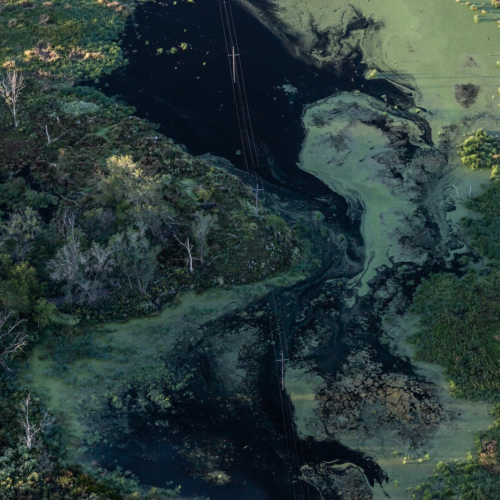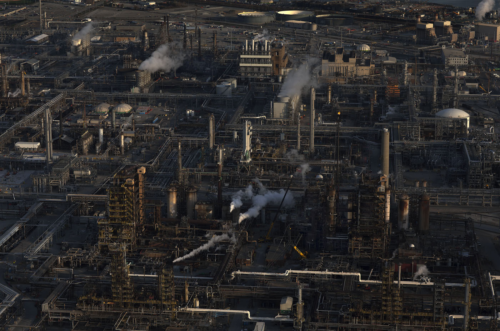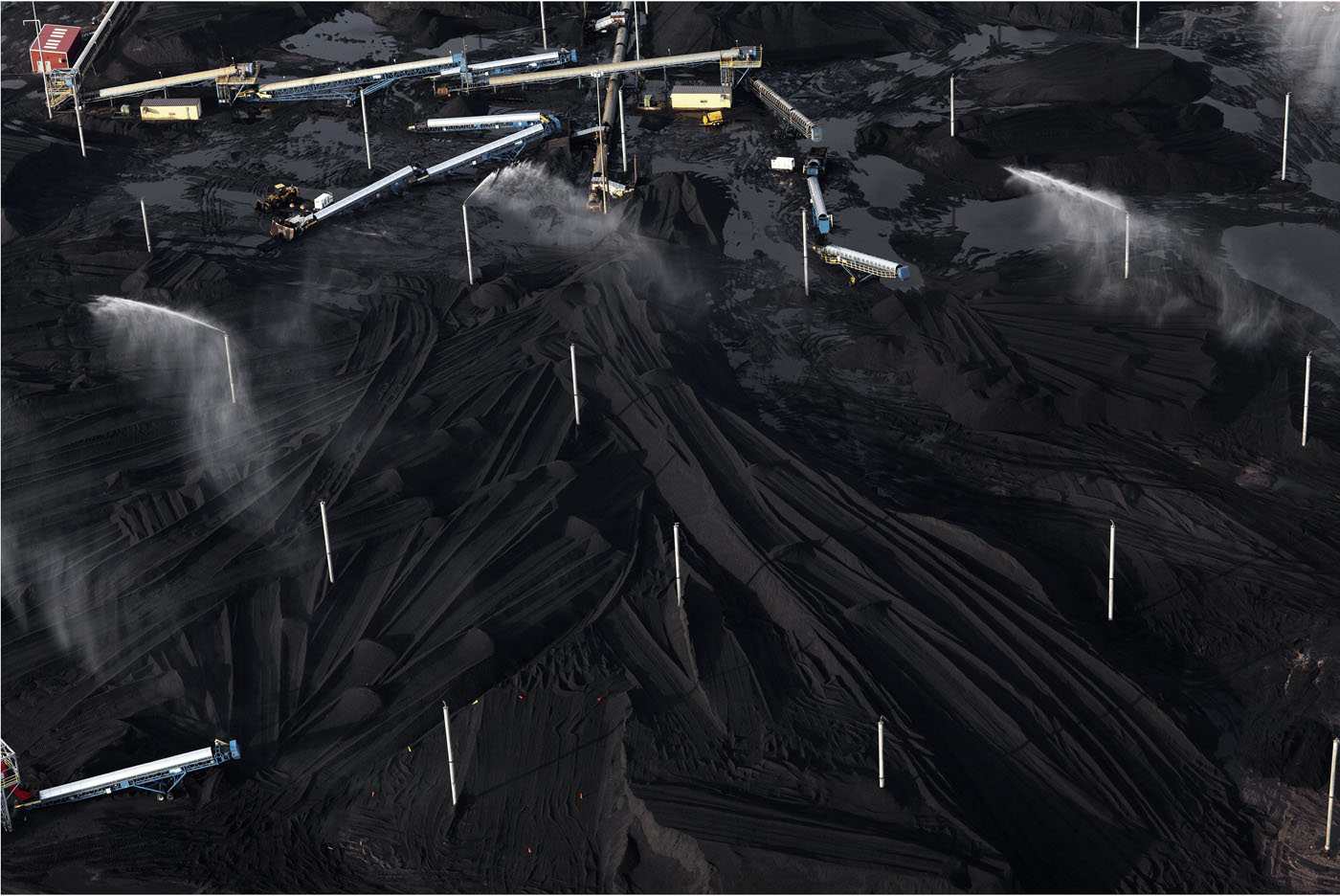In the middle of an empty room was a Plexiglas cube—and at the bottom of the cube, a fine sheet of black powder. An imaginary moonscape? An abandoned terrarium? Perhaps anticipating these questions, Beate Geissler and Oliver Sann, the Chicago-based artists behind the installation Prevailing Winds and Relative Distances, pasted several pages of text around the room.
The pages explained in blocks of Courier Bold—the typeface of a screenplay and, at one point, of the U.S. State Department—that the U.S. had produced 56 million metric tons of petroleum coke in 2014. According to Geissler and Sann’s arithmetic, this would break down into “5.68 grams [of] petroleum coke per square meter to cover all of the U.S., land and sea, evenly.”
But petroleum coke (or petcoke, as it’s commonly known) isn’t evenly spread across America. Rather, the dust, which according to the Environmental Protection Agency “poses an acute and chronic health threat to sensitive individuals,” is concentrated in manufacturing plants and open-air storage terminals across the Midwest.

Zones like these were the true nexus of Petcoke: Tracing Dirty Energy, a group exhibition that recently closed at the Museum of Contemporary Photography (MoCP). The center of gravity binding the artworks together wasn’t in the Loop, where the MoCP is located, but one hundred blocks south in Calumet Heights—more precisely, at the Koch Brothers-owned KCBX petcoke terminal.
Though the MoCP’s name suggests it would curate sedate Ansel Adams imitations or Diane Arbus homages, Tracing Dirty Energy worked successfully across mediums, seen in the inclusion of Marissa Lee Benedict and David Rueter’s film I Can Only See Shadows. According to the film’s description, Benedict and Rueter paired real footage of processing plants with fictional dramatizations to “create an imagined, parallel world where fossil fuel has been replaced [by an] untethered carbon particulate” which “transmits both energy and data.”
Both wordless and plotless, Shadows failed as a conventional film: I don’t think I would have picked up on the narrative at all if not for the explanation. And yet, like the best science fiction, it used a hypothetical world to depict our own—and presented a familiar scenario as something alien. There’s something uncanny about seeing towers of black dust and knowing not only that it’s not CGI, but that it’s not fiction.
A Library of Tears, an installation by SAIC professor Claire Pentecost, was more approachable, while it verged further into the surreal. The “library” suggested in the title referenced the array of blown glass teardrops suspended from the ceiling, each filled with detritus and ranging in scale from the size of a radish to a basketball.
The list of materials accompanying the work split the difference between a travelogue and a dystopian wine-tasting catalogue: it told of “South Dakota crude, Texas sweet crude, Alberta tar sands,” and “Athabascan River mud.” But Pentecost’s work also played with more familiar substances: one misshapen teardrop was stuffed with shredded U.S. bills; another was piled high with the corpses of tiny dead flies.
It was this sort of metaphor and allegory that kept Tracing Dirty Energy from getting too deadpan. Geissler and Sann, in particular—who included in their work a transcript of MoCP’s refusal of their original proposal to fill the gallery with petcoke dust—brought pitch-black humor to an otherwise straight-faced exhibition. The gravity of petcoke is impossible to miss, of course. But what Prevailing Winds and I Can Only See Shadows shared in common—despite their disparate mediums— was a firm grasp on the absurdity of the situation.
If these abstract pieces served to recontextualize the way we approach petcoke (i.e. as a nation inured to the costs of industrialization), then it was the literal-minded works which drove Tracing Dirty Energy’s message home. Consider Petcoke vs. Grassroots, a work by Hyde Park-based photographer Terry Evans. Here, the tension between the industry and the public was rendered visually: the first half of the work comprised bird’s-eye views of petroleum facilities; the second, interview transcripts and extreme close-ups of activists from the Southeast Side Environmental Task Force (SETF) and Coalition to Ban Petcoke.
Evans, who cites both Naomi Klein and the Pope as influences, spoke with me about aerial photography and her time organizing with The Coalition to Ban Petcoke on the Southeast Side.
“It’s one big example of how climate change is systemic,” Evans said. “They seem to have no regard for the local people. So for [locals] to organize and put enough pressure on the city, BP, and Koch Industries that they actually made some changes is a huge success.”

These changes gave us some good news to discuss: the EPA’s increased supervision of petcoke facilities, the election of 10th Ward Alderman Susan Garza—a local activist against petcoke pollution, and the class-action lawsuit against KCBX and other plants which concluded in a $1.45 million payout.
As Evans said: “Now, it’s what comes next.”
But what comes next, Evans acknowledged, isn’t that simple. For one thing, the narrative isn’t yet won—even after the settlement, KCBX has denied wrongdoing. Even more damning is the fact that the $1.45 million sum boils down to only about $60 for each eligible Southeast Side resident.
Then there’s the uncomfortable fact that facilities still in operation can apparently circumvent regulation with just a slap on the wrist—take the BP Whiting Refinery, for instance, which was investigated by the EPA for “water and air violations” after it dumped thirty-nine barrels of oil into Lake Michigan in March 2014. This August, the plant was found to have dumped into the lake five times the legal limit for waste, to the tune of 26,621 pounds . Then, there’s the fact that the issue of petcoke goes altogether beyond the fight on the Southeast Side—some companies have already moved to states with more lax regulations, where production will continue unimpeded.
This tragic Whac-A-Mole dynamic was made explicit in Brian Holmes’ Petropolis, which was simultaneously Tracing Dirty Energy’s least artistic and most disturbing offering. Petropolis, which can be viewed online, is not art so much as data visualization: it’s a topographical map of the United States, crosshatched by red lines depicting the routes that fossil fuels take in transit.
But an accompanying poster, labelled “Chicagoland on Fire,” brought genuine unease to this glut of information. “On July 6, 2013,” it began, “a train hauling Bakken crude exploded after derailing in the town of Lac Megantic, Québec, killing 47 people. Forty of these oil trains roll through Chicago area neighborhoods every week. All we know for sure is that they carry the 1267 hazmat placard.”
We don’t know what most of these freighters carry. We can’t say for certain how runoff waste will affect Lake Michigan, and we don’t know what the respiratory health of Calumet Heights residents will look like in a decade or two. We can make disturbing hypotheses about the future, but we can’t quite predict it. And so, Tracing Dirty Energy dwelled on the uncertainties: the known unknowns of the anthropocene.

